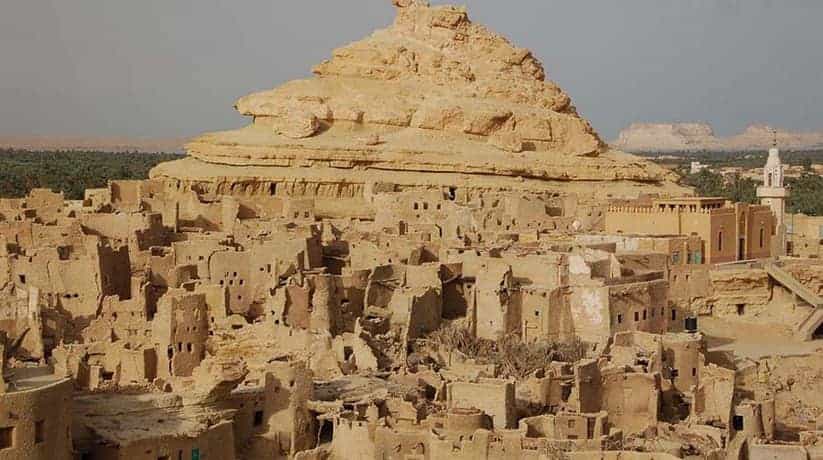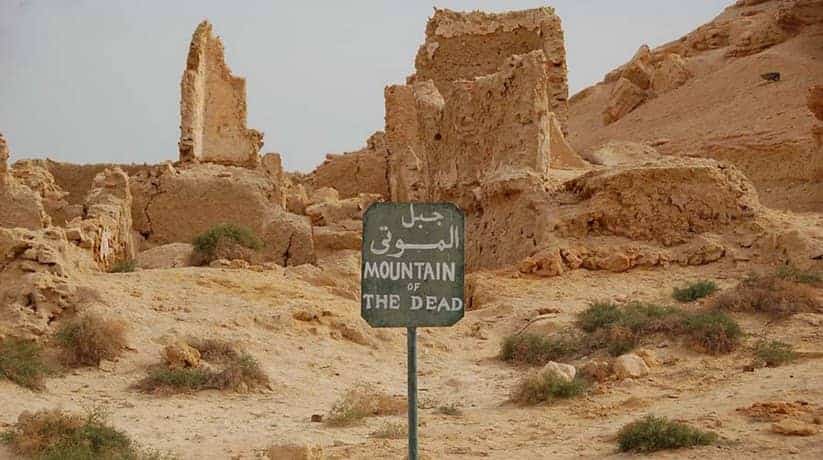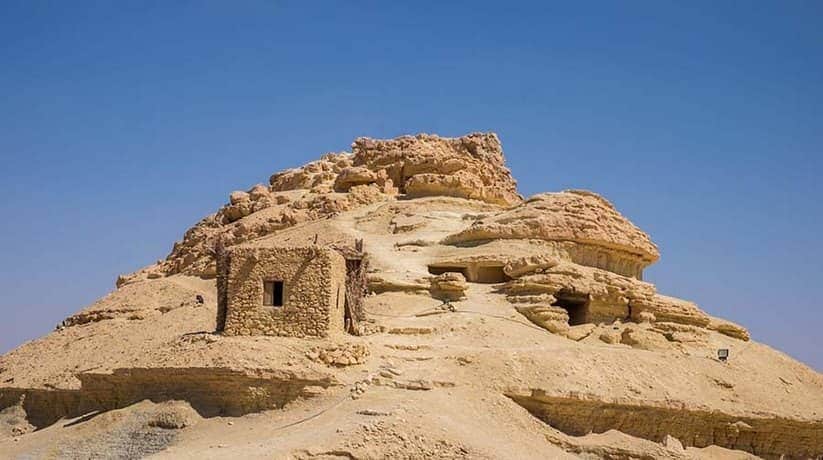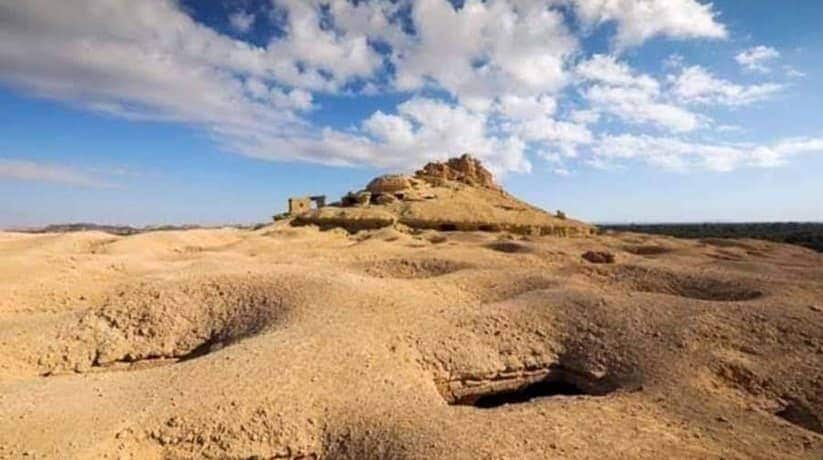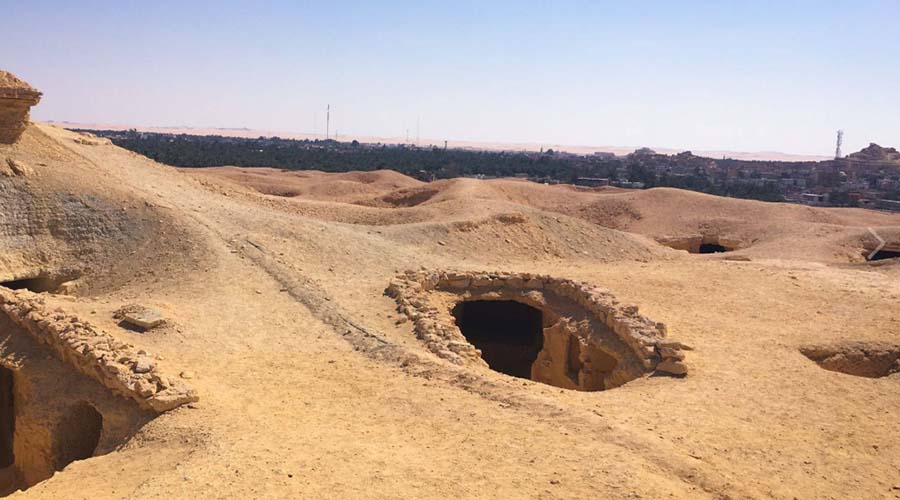Gebel Al Mawta Siwa Oasis information, tours, prices and online booking
Gebel Al Mawta Siwa Oasis is an Arabic translation of “Mountain of the Dead”. In fact, it known, for fairly obvious reasons. with this name. Here in this conical mountain, a little over a kilometer to the north of Shali a number of tombs are situated. In fact, they are along the main road from the escarpment. Local residents also call it Gebel Al Musabbarin, meaning Mountain of the Embalmed. In fact, the tombs cover every inch of its base and situated on its terraces. Moreover, they are on all sides of the conical part. The tombs in fact date back to the 26th Dynasty, the Greek (Ptolemaic) and the Roman periods. Though there appear to be no Christian burials.
In fact, this necropolis was one of the focuses of the early visitors to the Siwa. Browne permitted to visit it in 1792. At that time stated that the tombs contained neither inscriptions nor paintings. Hornemann, who visited the Siwa in 1798 mentions that the Siwans found gold inside the tombs. Furthermore, they were ravaging the ancient burials in search of more. The first traveler to mention drawings and paintings in the tombs Cailliaud. In fact, he visited Gebel Al Mawta on December 12th, 1819. He records that one of the most remarkable tombs contained three rooms. They are in fact one after the other, whose total length is 11 meters. Moreover, at right and left sides there are five chambers.
More information about Gebel Al Mawta Siwa Oasis:
On the walls of subterranean grottoes one finds the remains of hieroglyphs and Egyptian figures painted on the stucco. At the end there are two mutilated statues of a man and a woman cut in the rock, as it is generally seen in the Nile Valley. Interestingly, this tomb seems to be unidentified at this time. In fact, Muhammad Ali, the Ottoman ruler of Egypt, conquered Siwa oasis in 1820. The French consul from Cairo and other distinguished friends allowed to accompany the troops. Moreover, they also allowed to go wherever they wished, which was not always the case. They visited the mountain, but the notes of Drovetti add little to the writings of earlier visitors. However, later that same year, the German Consul from Egypt, Von Minutoli, visited the Siwa.
He refers to the tombs, stating that some of them painted with green. In fact, the other painted in red, yellow and blue colors. Moreover, they contained hieroglyphs. He also mentioned that the Siwans lived in some of the tombs of Gebel Al Mawta. During his stay a few hundred Bedouin of the Mjabir tribe from Tripoli were living in the tombs. A. Silva White was perhaps the first one who published photographs of the tombs. In fact, it was after he visited Siwa in 1897. Among other items, he acquired “a fairly large piece of painted wrapping”. In fact, it later described by Professor Sayce as “A mummy shroud, not incased in a coffin, but buried in the sand with bitumen” At the upper end is a picture of the deceased on his bier. In fact, it with Anubis standing beside him and pouring the waters of life over the body.
Further information about Gebel Al Mawta Siwa Oasis:
Moreover, it is while a worshipper stands on either side in an attitude of prayer. Below, on either side of the shroud, are figures of the four genii of the dead. In fact, this shroud presented to the Ashmolean Museum at Oxford and dated as Roman. Gebel Al Mawta is also where the emerald mines of the Siwa are thought to exist. According to G. E. Simpson in “The Heart of Libya”, Cailliaud found emeralds on Mount Zabarah. In fact, he presented ten pounds of them to Mohammad Ali, the ruler of Egypt at the time. Though there are some notable ones, most of the tombs on Gebel Al Mawta barren, and bones once littered the mountain. Tradition maintains that Radwan, the king of Siwa at the time of the Arab invasion of Egypt, took the bodies from Gebel Al Mawta.
Moreover, he threw them into many of the springs in an attempt to poison the enemy. The people of the Siwa believe the mountain to be haunted and will not venture there at night. In times of great rains and invasions by modern armies, the inhabitants go for protection. Moreover, they lived in the caves with the dead. Unfortunately, they also destroyed many of the caves. Moreover, they also chipped away the inscriptions and even violated the mummies in search of amulets. In fact, the locals of Siwa, as in other desert oases, have a certain mania for buried treasure. The diggers often come to the mountain in search of riches. No doubt, the mountain is the focus of such searches because of a passage in the written history of the Siwa known as the Siwan Manuscript.
More details about the site:
It states that in one of the tombs which is at its northern site there is a passage. It leads downwards and then turns eastwards until it reaches the treasury of King Khuraybish at Aghurmi”. According to the same document, the treasury of King Khuraybish, the last king of Siwa, buried in the Oracle Temple at Aghurmi. Finally, there were the reburials. In fact, most of the tombs robbed, probably in Roman times. Moreover, they also reused for burying the dead over many centuries afterwards. Side recesses (loculli) were cut in the walls for family burial places. It was in fact without regard for the previous tomb decorations. Most of the tombs are small and consist of only one or two chambers. Nevertheless, there are four tombs worth seeing, and possibly others.
Most of what we know about these tombs seems little updated since the work of Ahmed Fakhry. The four include the tomb of Niperpathot, one named the tomb of the Crocodile. Another known as the tomb of Mesu-Isis, who was really the wife of the tomb owner. For his name was unreadable, and the tomb of Si-Amun, which is probably the best of them. The tomb of Niperpathot is a large one, and one of the oldest in the oasis. In fact, it dates back probably to the 26th Dynasty. Moreover, it has a court with three rooms on either side. Furthermore, it is one of the few tombs on the mountain with inscriptions, here drawn in red. Niperpathot was the Prophet of Osiris and Scribe of the Divine Documents. His tomb contains his effigy and images of Osiris and Hathor.
Further details about the site:
In fact, the grave known as the Tomb of the Crocodile. It is a three room structure which excavated in 1941. In fact, the decorations are poor, but depict the goddess Hathor, the god Osiris, the tomb owner. Moreover, they also depict several animals, including a fox and of course a crocodile. The tomb in fact at Gebel Al Mawta dates back from fourth to the second centuries BC. The Unfinished Tomb of Mesu-Isis decorated on only one wall. Moreover, it has an excellent depiction of Uraiae (rows of cobras). In fact, it painted in red and blue on the cornice of the entrance. This tomb discovered in 1940 and there is evidence that it was robbed in antiquity. The owner’s name cannot deciphered, but his wife’s name is legible. In fact, the tomb known by her name. Finally, there is the tomb of Si-Amun. Ahmed Fakhry excavated all over the Western Desert.
In fact, he called this one the most beautiful in the Western Desert. Si-Amun appears to b a wealthy man, perhaps even a Greek, but a follower of the ancient Egyptian religion. His tomb contains images from the Egyptian pantheon. In fact, it includes a fine painting of the Goddess Nut standing beside a sycamore tree. Moreover, this tomb discovered in 1940, and has unfortunately deteriorated since then. Though there is still much to see. There are many other un-inscribed tombs at Gebel Al Mawta Siwa Oasis. Ahmed Fakhry excavated here in 1938 and 1939. In fact, he was optimistic that more inscribed tombs discovered once additional excavations carried out. He points out that most of the bodies he found poorly mummified. Moreover, they prepared in more or less the same way as in the Nile Valley.
More details about Gebel Al Mawta Siwa Oasis:
The coffins and amulets were also the same as in the Nile Valley. That is why Fakhry believed that the people of the Siwa, at least during Ptolemaic and Roman times, completely “Egyptianized”. Fakhry further notes that many of the skulls and other bones found in the ravaged tombs of the Siwa brought to Cairo in the 1920’s and carefully studied by Professor D. Derry. Though we now have little information on how closely Dr. Derry’s methods would compare to modern analysis. In fact, he concluded that the Siwans of Ptolemaic and Roman times were not exactly the same as contemporary Nile Valley Egyptians. They are more similar to Europeans racially in fact. Note that on a spur of the mountain below the tombs are an ethnographic exhibit. They fill the interior of a traditional mud-brick house. They mostly contain displays of tools and pottery used by the locals.

